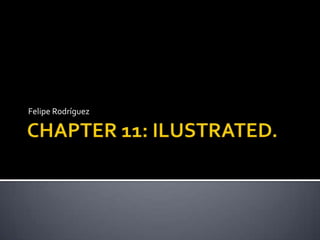
The Cell Cycle
- 1. CHAPTER 11: ILUSTRATED. Felipe Rodríguez
- 2. AllImagestakenform: Audeirk, D. Audesirk, J & Byers, B. (2008) Biology with Physiology: Life on Earth. New Jersey. : Pearson.
- 3. ASEXUAL REPRODUCTION. Paramecium sp. Is a protists, a microorganism. Yeast, a unicellular fungus reproduces asexually. Hydra a sea animal, reproduces a sexually. It starts growing a bud until it grows big enough to be an independent organism.
- 4. PROKARYOTIC CELL CYCLE. Prokaryotic Cell Cycle consist of DNA growth and former cell division. Cell Division in Prokaryotic cells is called BINARY FISSION.
- 5. EUCARYOTIC CELL CYCLE. This cycle consist of the following main phases: Interphase(Yellow). Cell Division (Light Blue). Interphase has 4 phases: G1,G0, S and G2. Cell Division could be either: Mitosis or Meiosis
- 6. CHROMOSOME. A human chromosome consist of a single DNA double helix and some proteins called Histones and scaffolds. Chromosomes are a compact DNA container.
- 7. CHROMOSOME. These are the main features of chromosomes: Genes: sequences of DNA that have an specific function. Centromere: it joins two parts of the chromosome, it does NOT have to be at the center. Telomeres: the “end” of the chromosome, they maintain the equilibrium and seal the chromosome’s material.
- 8. DUPLICATED CHROMOSOME. A duplicated chromosome consist of two identical chromosomes.
- 9. KARYOTYPE. A karyotype is the full set of chromosomes located at each cell of an organisms. All this chromosomes are located at the nucleus. They consist of homologues pairs. For example, chromosome 1 consists of two identical chromosomes. They share the same genes at the same order and the same length. Exception: sexual chromosomes. This photo is from a male, since it has XY, if it were from a women’s it would be XX.
- 14. CYTOKINESIS: PLANT CELL. During Cytokinesis in plan cells, once the cell is divided , the Golgi Apparatus starts sending vesicles with carbohydrates (cellulose) to start creating a cell wall in-between both daughter nuclei.
- 16. After G2: Has DNA replication successfully occurred?
- 18. ALLELES. Homologues have same of different Alleles. Alleles are variations of the same gene, that determine different characteristics.
- 19. MEIOTIC CELL DIVISION. Both members of a pair of homologues chromosomes are replicated before Meiosis. One chromosome is parental and the other is maternal.
- 20. MEIOSIS I. After MEIOSIS I, each daughter cell receives one of each pair of homologues chromosomes.
- 21. MEIOSIS II. After MEIOSIS II, sister chromatids separate into independent chromosomes and each daughter cell receives one of these chromosomes.
- 22. MEIOSIS I.
- 23. CROSSING OVER. Crossing Over occurs at Prophase I and it adds genetic diversity to the chromosomes.
- 24. METAPHASE I. Homologues chromosomes are paired up taking as a reference the Equator. Each PAIR of chromatids gas a single functional kenitochore. In MITOSIS, each sister chromatids have one kenitochore.